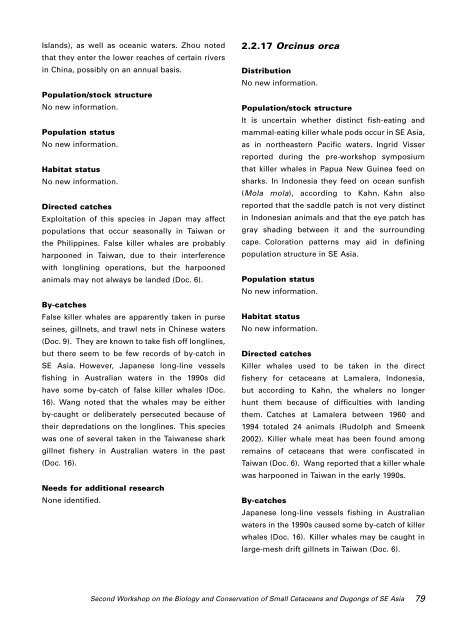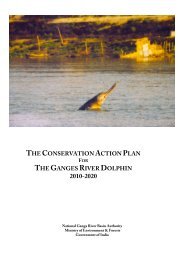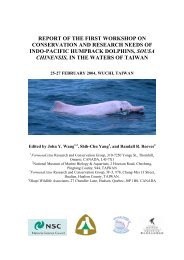Report of the Second Workshop on The Biology and Conservation of ...
Report of the Second Workshop on The Biology and Conservation of ...
Report of the Second Workshop on The Biology and Conservation of ...
Create successful ePaper yourself
Turn your PDF publications into a flip-book with our unique Google optimized e-Paper software.
Isl<strong>and</strong>s), as well as oceanic waters. Zhou notedthat <str<strong>on</strong>g>the</str<strong>on</strong>g>y enter <str<strong>on</strong>g>the</str<strong>on</strong>g> lower reaches <str<strong>on</strong>g>of</str<strong>on</strong>g> certain riversin China, possibly <strong>on</strong> an annual basis.Populati<strong>on</strong>/stock structureNo new informati<strong>on</strong>.Populati<strong>on</strong> statusNo new informati<strong>on</strong>.Habitat statusNo new informati<strong>on</strong>.Directed catchesExploitati<strong>on</strong> <str<strong>on</strong>g>of</str<strong>on</strong>g> this species in Japan may affectpopulati<strong>on</strong>s that occur seas<strong>on</strong>ally in Taiwan or<str<strong>on</strong>g>the</str<strong>on</strong>g> Philippines. False killer whales are probablyharpo<strong>on</strong>ed in Taiwan, due to <str<strong>on</strong>g>the</str<strong>on</strong>g>ir interferencewith l<strong>on</strong>glining operati<strong>on</strong>s, but <str<strong>on</strong>g>the</str<strong>on</strong>g> harpo<strong>on</strong>edanimals may not always be l<strong>and</strong>ed (Doc. 6).By-catchesFalse killer whales are apparently taken in purseseines, gillnets, <strong>and</strong> trawl nets in Chinese waters(Doc. 9). <strong>The</strong>y are known to take fish <str<strong>on</strong>g>of</str<strong>on</strong>g>f l<strong>on</strong>glines,but <str<strong>on</strong>g>the</str<strong>on</strong>g>re seem to be few records <str<strong>on</strong>g>of</str<strong>on</strong>g> by-catch inSE Asia. However, Japanese l<strong>on</strong>g-line vesselsfishing in Australian waters in <str<strong>on</strong>g>the</str<strong>on</strong>g> 1990s didhave some by-catch <str<strong>on</strong>g>of</str<strong>on</strong>g> false killer whales (Doc.16). Wang noted that <str<strong>on</strong>g>the</str<strong>on</strong>g> whales may be ei<str<strong>on</strong>g>the</str<strong>on</strong>g>rby-caught or deliberately persecuted because <str<strong>on</strong>g>of</str<strong>on</strong>g><str<strong>on</strong>g>the</str<strong>on</strong>g>ir depredati<strong>on</strong>s <strong>on</strong> <str<strong>on</strong>g>the</str<strong>on</strong>g> l<strong>on</strong>glines. This specieswas <strong>on</strong>e <str<strong>on</strong>g>of</str<strong>on</strong>g> several taken in <str<strong>on</strong>g>the</str<strong>on</strong>g> Taiwanese sharkgillnet fishery in Australian waters in <str<strong>on</strong>g>the</str<strong>on</strong>g> past(Doc. 16).Needs for additi<strong>on</strong>al researchN<strong>on</strong>e identified.2.2.17 Orcinus orcaDistributi<strong>on</strong>No new informati<strong>on</strong>.Populati<strong>on</strong>/stock structureIt is uncertain whe<str<strong>on</strong>g>the</str<strong>on</strong>g>r distinct fish-eating <strong>and</strong>mammal-eating killer whale pods occur in SE Asia,as in nor<str<strong>on</strong>g>the</str<strong>on</strong>g>astern Pacific waters. Ingrid Visserreported during <str<strong>on</strong>g>the</str<strong>on</strong>g> pre-workshop symposiumthat killer whales in Papua New Guinea feed <strong>on</strong>sharks. In Ind<strong>on</strong>esia <str<strong>on</strong>g>the</str<strong>on</strong>g>y feed <strong>on</strong> ocean sunfish(Mola mola), according to Kahn. Kahn alsoreported that <str<strong>on</strong>g>the</str<strong>on</strong>g> saddle patch is not very distinctin Ind<strong>on</strong>esian animals <strong>and</strong> that <str<strong>on</strong>g>the</str<strong>on</strong>g> eye patch hasgray shading between it <strong>and</strong> <str<strong>on</strong>g>the</str<strong>on</strong>g> surroundingcape. Colorati<strong>on</strong> patterns may aid in definingpopulati<strong>on</strong> structure in SE Asia.Populati<strong>on</strong> statusNo new informati<strong>on</strong>.Habitat statusNo new informati<strong>on</strong>.Directed catchesKiller whales used to be taken in <str<strong>on</strong>g>the</str<strong>on</strong>g> directfishery for cetaceans at Lamalera, Ind<strong>on</strong>esia,but according to Kahn, <str<strong>on</strong>g>the</str<strong>on</strong>g> whalers no l<strong>on</strong>gerhunt <str<strong>on</strong>g>the</str<strong>on</strong>g>m because <str<strong>on</strong>g>of</str<strong>on</strong>g> difficulties with l<strong>and</strong>ing<str<strong>on</strong>g>the</str<strong>on</strong>g>m. Catches at Lamalera between 1960 <strong>and</strong>1994 totaled 24 animals (Rudolph <strong>and</strong> Smeenk2002). Killer whale meat has been found am<strong>on</strong>gremains <str<strong>on</strong>g>of</str<strong>on</strong>g> cetaceans that were c<strong>on</strong>fiscated inTaiwan (Doc. 6). Wang reported that a killer whalewas harpo<strong>on</strong>ed in Taiwan in <str<strong>on</strong>g>the</str<strong>on</strong>g> early 1990s.By-catchesJapanese l<strong>on</strong>g-line vessels fishing in Australianwaters in <str<strong>on</strong>g>the</str<strong>on</strong>g> 1990s caused some by-catch <str<strong>on</strong>g>of</str<strong>on</strong>g> killerwhales (Doc. 16). Killer whales may be caught inlarge-mesh drift gillnets in Taiwan (Doc. 6).<str<strong>on</strong>g>Sec<strong>on</strong>d</str<strong>on</strong>g> <str<strong>on</strong>g>Workshop</str<strong>on</strong>g> <strong>on</strong> <str<strong>on</strong>g>the</str<strong>on</strong>g> <strong>Biology</strong> <strong>and</strong> C<strong>on</strong>servati<strong>on</strong> <str<strong>on</strong>g>of</str<strong>on</strong>g> Small Cetaceans <strong>and</strong> Dug<strong>on</strong>gs <str<strong>on</strong>g>of</str<strong>on</strong>g> SE Asia 79





